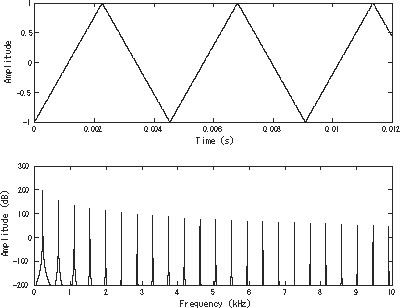 | ||
A triangle wave is a non-sinusoidal waveform named for its triangular shape. It is a periodic, piecewise linear, continuous real function.
Contents
Like a square wave, the triangle wave contains only odd harmonics, demonstrating odd symmetry. However, the higher harmonics roll off much faster than in a square wave (proportional to the inverse square of the harmonic number as opposed to just the inverse).
Harmonics
It is possible to approximate a triangle wave with additive synthesis by adding odd harmonics of the fundamental, multiplying every (4n−1)th harmonic by −1 (or changing its phase by π), and rolling off the harmonics by the inverse square of their relative frequency to the fundamental.
This infinite Fourier series converges to the triangle wave with cycle frequency f over time t:
Definitions
Another definition of the triangle wave, with range from -1 to 1 and period 2a is:
Also, the triangle wave can be the absolute value of the sawtooth wave:
or, for a range from -1 to +1:
The triangle wave can also be expressed as the integral of the square wave:
A simple equation with a period of 4, with
or, a more complex and complete version of the above equation with a period of
The function (1) is a specialization of (2), with a=2 and p=4:
An odd version of the function (1) can be made, just shifting by one the input value, which will change the phase of the original function:
Generalizing the formula (3) to make the function odd for any period and amplitude gives:
In terms of sine and arcsine with period p and amplitude a:
Note: sin y = cos x
Arc Length
The arc length per period "s" for a triangle wave, given the amplitude "a" and period length "p":
